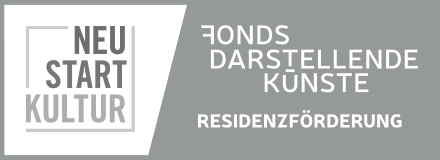
First of all, it should be highlighted that the Theatre in Der Kurve is incredibly atmospheric, which creates favourable conditions for creativity.
We were lucky enough to work with our mentor, Mareike Buchmann, during our first day of the residency. Together we tried a number of plastic and spatial improvisations with objects. The task was to distribute ourselves and our bodies on the stage, to feel the aura of the objects.

The question arose as to what text material to concentrate on, whether to take dramatic or literary material as a basis. To be inspired by it or to create our own stories. As planned before the residency began, we worked with well-known plots of folk tales from Ukraine and Germany. As inspiration. It was suggested that we focus on the theme of human behaviour and human nature, which is weak and subject to temptations (power, strength, ambition, wealth, etc.). These serious themes (though at first glance in children’s fairy tales) always appear in folklore stories.
The next day was dedicated to continuing improvisational work with objects. It was suggested to choose objects with different textures, properties and qualities and explore them. The second aspect of the research was the behaviour of the performer during her time on stage with the objects – what thoughts, feelings, desires, emotions (positive or negative) a particular object evokes and what physical interaction and manipulation with it inspires. In other words, a reflection on one’s own emotional and volitional state during the research of an object.

One of the tasks was to create a story with the object. It was suggested to work only plastically, limiting narrative as an additional means of expression. However, this caused a number of complications. There was a tendency for the object to seem insufficient, a constant struggle with the predominance of the word. It was allowed to use the word as an experiment, but not as the dominant means of expression.
The following days of creative work also presented some challenges, as the objects did not “speak”. The performer spoke for them. Each day begins with a warm-up in order to find not only inspiration, free ourself from physical constraints, prepare our bodies for work, but also to find the right vector of interaction with the object.
It was decided not to scatter attention on many objects, but to concentrate on only certain objects – a stick, a skirt, a chair, a rope. Simple objects that can be manipulated in many ways, and thus given a different “sound” and meaning through physical metamorphosis.
This exercise was the starting point of the second stage of work with objects. It was decided to do the following training exercises before trying to tell a story (with object or about an object):
1. Find as many other physical and meaningful dimensions for the object as possible (for example, a skirt can be a child in diapers, the sea, a bird, the wings etc.)
2. Find different “gaits” for the objects, i.e. try to find different plasticity of the objects (crawling, walking, rolling etc.), which gives different feelings of character and forms different attitudes in both the performer and the spectator
3. Find up to 5 different ways to “move” the object on stage (on the head, in the hands, on the back etc.), also looking for a semantic load in this.
After completing these three exercises, the writers were asked to try to tell stories with a minimum number of words.

An interesting story was found about the transformation of a kind, gentle, interested child into a monster, similar to his oppressors. The story was invented and told using only a stick. The stick as an object was used both as an acting character (a boy) and as a prop to enhance the perception of the story. The second option was more clear for perception of the story.
The new idea was born – to tell several stories using only three simple objects (each story with each object in turn): a stick, a stone, and a wheel. The choice of these objects is based on the philosophy of the development of civilisation – from the time when the main tool was only a wooden stick, to the Stone Age, to the wheel as an image of the development of civilisation and progress. However, the theme that unites these stories should remain the same: human nature is weak and subject to various temptations. Human being as the main topic of research was raised from the first meetings.
The question was also raised of how to depict different concepts with different means of expression – spring, autumn, winter, summer – as the four seasons. How to show them using such objects as paper, cellophane and other textures? How does this change the nature of the actor’s existence?
The four seasons gave an impetus to the analysis of the theme of the cyclical nature of human existence, and, accordingly, the four basic elements of the universe – earth, water, air, and fire. As well as the idea of human sins, the seven deadly sins, which are also always reflected in folklore stories.
The two days of meeting and working with the mentor changed the development of the research somewhat, but at the same time strengthened the already outlined trends.
Mareike Buchmann, as an artist in the field of physical and plastic theatre, suggested that we intensify our research in the field of physical reflection. It was proposed to choose a topic for research for two days of work with a mentor. The choice was fixed on the topic of metamorphosis (since the topic of human behaviour and human existence is too wide for a two-day period of work with a mentor).

Apparently, the ideas of previous research were in the air, so it was decided to focus on the metamorphosis of the four seasons and how to show it in a plastic way. In the process of searching, interesting visual images: were born: a pendulum as an image of the relentless movement of time, circular mise-en-scene as an image of the annual cycle.
Attempts were made to find a different sounds for each season of the year on different musical instruments and voice. Together with the mentor, the paper transformation exercises to find apt visual images that demonstrate the metaphors of nature in connection with the changing seasons were conducted. Mareike Buchmann advised not to focus on just one template vision and idea of summer, spring, winter and autumn, but to remember the so-called “passages,” i.e. transitions, moods, atmospheres, which can be represented in an interesting way in plastic.
As a result of the work, the nature of movements for each of the seasons was systematised:
1. Spring (spirals, turns, shy gestures that come from within the body, the mise-en-scene of the body expresses timidity but interest, half-turns to the audience as an image of a sprout that has not yet bloomed).
2. Summer (broad, wide gestures, desire to spread oneself and one’s energy, the mover is self-confident, the body mise-en-scene is frontal, open to the audience).
3. Autumn (movements are somewhat tired, trembling, loss of fluidity of the position, body rotation away from the audience).
4. Winter (the body’s mise-en-scene is inclined, the nature of the movements is inactive and with large amplitudes of line changes – as if breaking, freezing, dying).
The performer’s eyes are important in each phase of the movement. The need to look for new “centres of gravity” in the body in each season (abdomen, fingers, pelvis, groin and to look for different plastics was emphasised.
There are also exercises to find the voice and noise signature for each season of the year.

Many of the exercises were conducted outdoors, surrounded by nature.
A plan of action for further searches is outlined:
1. To find an accurate pattern of plastic to reflect the metamorphosis by means of the performer’s expressive talent.
2. To convey the metamorphoses of the annual cycle using paper (different in texture and sound).
3. Look for noise (instrumental?) expressions of the character of each of the seasons and the changes (so-called “passages”) between them.

flausen+headquarters
Alexanderstraße 124
26121 Oldenburg
flausen+gGmbH
Klävemannstraße 16
26122 Oldenburg
Das überregionale Netzwerk flausen+ wird gefördert von der Beauftragten der Bundesregierung für Kultur und Medien über das Programm “Verbindungen fördern” des Bundesverbands Freie Darstellende Künste e.V.
Gefördert vom Fonds Darstellende Künste aus Mitteln der Beauftragten der Bundesregierung für Kultur und Medien im Rahmen von NEUSTART KULTUR.
Gefördert vom Fonds Darstellende Künste aus Mitteln der Beauftragten der Bundesregierung für Kultur und Medien.



